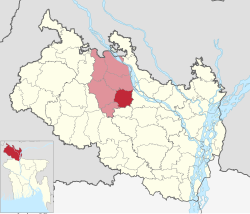Kishoreganj Upazila
 From Wikipedia the free encyclopedia
From Wikipedia the free encyclopedia
Kishoreganj কিশোরগঞ্জ | |
|---|---|
 View of island in Jamuneshwari River | |
 | |
| Coordinates: 25°54.7′N 89°1.5′E / 25.9117°N 89.0250°E | |
| Country | |
| Division | Rangpur |
| District | Nilphamari |
| Area | |
| • Total | 205.01 km2 (79.15 sq mi) |
| Population | |
| • Total | 269,332 |
| • Density | 1,300/km2 (3,400/sq mi) |
| Time zone | UTC+6 (BST) |
| Postal code | 5320[2] |
| Website | Official Map of Kishoreganj |
Kishoreganj (Bengali: কিশোরগঞ্জ) is an upazila of Nilphamari District in the Division of Rangpur, Bangladesh.[3]
History
[edit]The upazila was named after Prince Kishore Chandro, son of Horish Chandro (1800–1900). Kishorganj was known for Nil cultivation while under British ruling. It was part of Nilphamari Mohokuma of Rangpur District. When Nilphamari became separate district, it became a Upazila of that district in 1983.
Geography
[edit]Kishoreganj is located at 25°54′40″N 89°01′30″E / 25.9111°N 89.0250°E. It has a total area of 205.01 km2. The upazila is bounded by Jaldhaka upazila on the north, Taraganj upazila on the south, Gangachara upazila on the east, Nilphamari sadar and Saidpur upazilas on the west.[3]
Demographics
[edit]| Year | Pop. (000) | ±% |
|---|---|---|
| 1981 | 208 | — |
| 1991 | 246 | +18.3% |
| 2001 | 253 | +2.8% |
| 2011 | 261 | +3.2% |
| 2022 | 269 | +3.1% |
| Source: Bangladesh Bureau of Statistics[4] | ||
According to the 2011 Census of Bangladesh, Kishoreganj Upazila had 65,798 households and a population of 261,069. 65,155 (24.96%) were under 10 years of age. Kishoreganj had a literacy rate (age 7 and over) of 38.48%, compared to the national average of 51.8%, and a sex ratio of 994 females per 1000 males. 8,444 (3.23%) lived in urban areas.[4][6]
As of the 1991 Bangladesh census, Kishoreganj has a population of 246201. Males constitute 51.19% of the population, and females 48.81%. This Upazila's eighteen up population is 122233. Kishoreganj has an average literacy rate of 18.2% (7+ years), and the national average of 32.4% literate.[7]
Economy
[edit]The fertile land of Kishoreganj produces mainly potato, rice, ginger and corn. The season's first Potato harvest happens here and transported to all main cities at the beginning of December.
Administration
[edit]Kishoreganj Thana, now an upazila, was formed in 1921.[8]Kishoreganj was part of Dimla thana of Nilphamari Mohokuma before becoming a separate thana.
Kishoreganj Upazila is divided into nine union parishads: Bahagili, Barabhita, Chandkhana, Garagram, Kishoreganj, Magura, Nitai, Putimari, and Ranachandi. The union parishads are subdivided into 51 mauzas and 53 villages.[4]
See also
[edit]References
[edit]- ^ National Report (PDF). Population and Housing Census 2022. Vol. 1. Dhaka: Bangladesh Bureau of Statistics. November 2023. p. 403. ISBN 978-9844752016.
- ^ "Bangladesh Postal Code". Dhaka: Bangladesh Postal Department under the Department of Posts and Telecommunications of the Ministry of Posts, Telecommunications and Information Technology of the People's Republic of Bangladesh. 21 October 2024.
- ^ a b Md. Azizul Islam Promanik (2012), "Kishoreganj Upazila (Nilphamari)", in Sirajul Islam and Ahmed A. Jamal (ed.), Banglapedia: National Encyclopedia of Bangladesh (Second ed.), Asiatic Society of Bangladesh
- ^ a b c "Bangladesh Population and Housing Census 2011 Zila Report – Nilphamari" (PDF). bbs.gov.bd. Bangladesh Bureau of Statistics.
- ^ Population and Housing Census 2022 - District Report: Nilphamari (PDF). District Series. Dhaka: Bangladesh Bureau of Statistics. June 2024. ISBN 978-984-475-285-6.
- ^ "Community Tables: Nilphamari district" (PDF). bbs.gov.bd. Bangladesh Bureau of Statistics. 2011.
- ^ "Population Census Wing, BBS". Archived from the original on 2005-03-27. Retrieved November 10, 2006.
- ^ "Kishoreganj Upazila (Nilphamari) - Banglapedia". en.banglapedia.org. Retrieved 2023-02-22.
